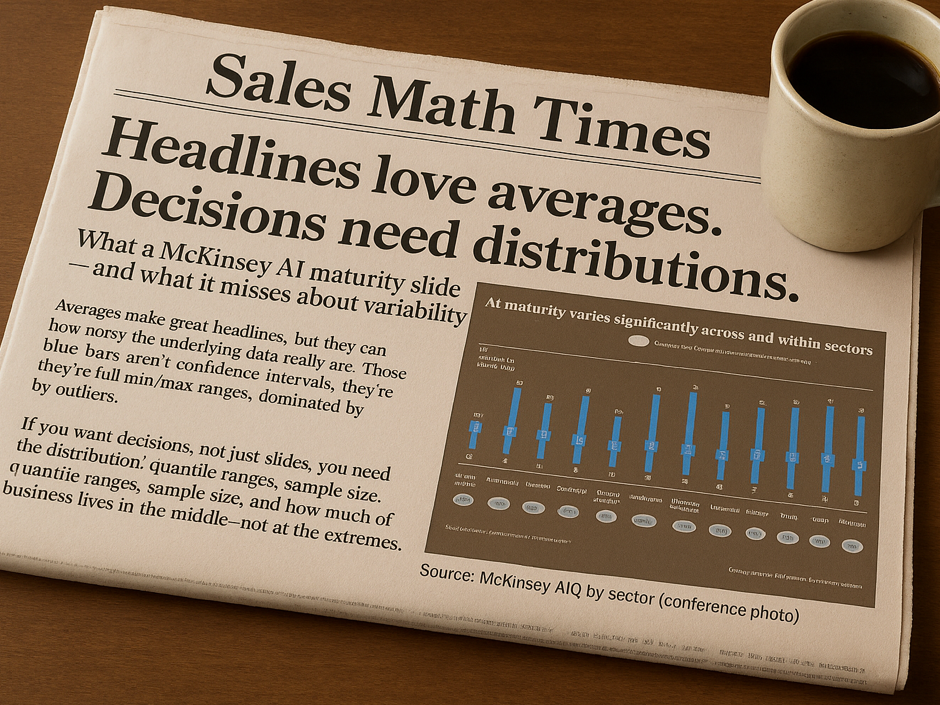A Tale of Three Knobs
- Bill Kantor

- Mar 25, 2023
- 3 min read
Updated: Jan 10
Your sales process is defined by three independent factors: deal size, generation rate, and win rate. Want to grow sales? Those are the three knobs you have.

Steve Rietberg at Gartner, Gary Smith Partnership, Jacco van der Kooij at Winning By Design, Mark Kosoglow, AJ Beltis at Hubspot, and countless others… What do they have in common?
They understand that deal size, generation rate, and win rate are all you control.
To control something, you need to measure it. Measuring deal size and generation rates are relatively straightforward. That’s why there are so many blogs about win rates.
“Win rate” has become a generic term used when managers or leaders are looking to quantify a seller or team’s success at closing deals. Win rate is a suitable metric for that purpose, but its value in predictive analytics and forecasting is limited. (Emphasis added.)
Why? What does Gartner know about this? Let’s look to others.
Gary Smith Partnership, explains the problem that Gartner hints about.
… the conversion rate [win rate] is the value of closed-won deals in a month as a proportion of the total open pipeline. However, this gives a distorted win rate. For example, let’s say your sales cycle is three months. That means deals created today are unlikely to close for another two to three months. So they are not relevant to the sales conversion rate for this month. In other words, if the sales team closes the usual number of deals this month and does a great job creating pipeline opportunities, the win rate is artificially low. … The Right Way To Measure Sales Conversion Rates You measure opportunity win rates by comparing the number and value of deals won with those lost in the same period.
That’s interesting. Looking only at lost and won, you are insulated from changes in creating pipeline (this month anyway). But what about all the deals that weren’t won or lost? Could that inflate the win rate?
Jacco at Winning By Design nails this issue as well.
In a healthy economy, it is not uncommon to see a temporary, even steep, decline in the win rate, often attributed to a significant increase in opportunities, for example, after a tradeshow or web event.
Mark Kosoglow has an even more nuanced understanding of the issues.
Confusing period-based vs cohort-based data sets is an assassin.
By “period-based,” Mark means analyses similar to the previous posts where the win rates are influenced by generation rates. By “cohort-based” he means selecting a cohort and waiting however long is needed to measure the win rates. Rather than replicate it here, I suggest you read Mark’s analysis of the difference between these two approaches. His conclusions:
Period-based data sets are better for counting stat-based measurements against targets (e.g. did we book enough meetings this quarter). Cohort-based data sets are better for conversion rate measurements against targets (e.g. did enough of our booked meetings hold). Overall, the real challenge is not clearly identifying these 2 types of analysis and making sure to draw appropriate conclusions. This is why you feel so confused and frustrated whenever you look at period-based data and wonder why a conversion rate looks totally off! (Emphasis added.)
Mark is poking at the same issue that Gartner, Gary Smith, and Winning By Design brought up.
Hubspot has an interesting recommendation:
In the simplest terms, sales win rate is calculated by dividing closed-won deals by all deal-stage prospects that either did or did not become customers.
That’s a usable definition but it does not say how to select the deals in your cohort, or how long to wait to measure the win rate.
See how to sell more. Try Funnelcast. |
Stepping back, what’s going on here is that all these posters are aware of a fundamental problem. The way that people are measuring win rates mixes two fundamentally independent factors of your business: generation rate and win rate.
To measure win rate independent of the other two knobs, you have to think a bit harder. Mark Kosoglow is on the right path, advocating that you need to define a cohort, incorporate all outcomes (won, lost, and open), and wait long enough. But he leaves it up to you to figure that out.
Here’s the solution—including instructions and a downloadable Excel workbook you can just paste your data into.




Comments